Our team is highly trained and experienced in servicing and producing all types of steel supplies. Need help or have a question?
sales@abrasionresistantpipe.com
Tel.: +8621-3378-0199
Our team is highly trained and experienced in servicing and producing all types of steel supplies. Need help or have a question?
sales@abrasionresistantpipe.com
Tel.: +8621-3378-0199

DIN 17175 10CrMo910 seamless steel tubes are high-pressure alloy steel tubes used mainly in boilers, superheaters, and heat exchangers.
DIN 17175 10CrMo910 seamless steel tubes are high-pressure alloy steel tubes used mainly in boilers, superheaters, and heat exchangers.
DIN 17175 10CrMo910 seamless steel tubes are designed to withstand high temperatures and high pressures, making them suitable for use in applications where extreme conditions are present. The tubes are made using high-quality raw materials and are subjected to rigorous testing to ensure their durability and strength. The tubes have a smooth surface finish, excellent chemical and mechanical properties, and are resistant to corrosion and oxidation. Additionally, they are highly reliable and require minimal maintenance, making them ideal for use in critical applications such as power plants, refineries, and petrochemical industries.
DIN 17175 10CrMo910 belongs to 2.25Cr-1Mo pearlitic heat-resistant steel, which has good physical and chemical properties and process properties, low heat treatment sensitivity, high heat strength and metallographic structure stability in long-term use at high temperature.
DIN 17175 10CrMo910 Seamless Steel Tubes can be used to manufacture steam boilers, pipes, pressure vessels and instruments operating at temperatures up to 600 ° C and at high temperatures.
| Steel Grade | Thermal processing ℃ | Normalizing℃ | Tempering | ||
| Grade | Material number | Quenching temperature ℃ | Tempering temperature ℃ | ||
| 10CrMo910 | 1.7380 | 1100 to 850°C | – | 900-960 | 700-750 |
| Grade | Chemical composition | |||||
| C | Si | Mn | P、S | Cr | Mo | |
| 10CrMo910 | 0.08-0.15 | ≤0.50 | 0.40-0.70 | ≤0.030 | 2.00-2.50 | 0.90-1.20 |
| Standard | Grade | Tensile Strength(MPa) | Yield Strength(MPa) | Elongation(%) |
| DIN 17175 | 10CrMo910 | 450-600 | ≥280 | ≥18 |
When DIN 17175 10CrMo910 alloy steel pipe is welded, if the welding rod and welding wire with the same strength as the base metal are selected, the plasticity of the welding joint obtained is poor, the preheating temperature is required to be 400-450 ℃, the preheating temperature is high, and the construction conditions are poor; in order to improve the plasticity of the welded joint, it is necessary to conduct 740 ℃ heat preservation for 3h high temperature tempering after welding. However, high temperature preheating and high temperature tempering for a long time will cause obvious softening of the HAZ.
If the electrode and welding wire with slightly lower strength and better plasticity are selected, the preheating temperature will be greatly reduced (actual operation 250-300 ℃), the high temperature tempering temperature will also be reduced, the tempering treatment time will be shortened, and 700-720 ℃ will be kept for 1H for tempering, which is enough to eliminate the welding stress and will not cause the softening of the heat affected zone of welding. Therefore, r317 electrode and h08crmoa welding wire are generally used for DIN 17175 10CrMo910 alloy steel pipe welding.
| Project | Standard | Size range | Tolerance | |||
| Outer diameter | DIN17175 | Hot rolled steel pipe | OD ≤ 100mm | ± 0.75%( Min ± 0.5mm ) | ||
| OD> 100~ 320mm | ± 0.9% | |||||
| Cold drawn steel pipe OD ≤ 120mm | ± 0.6%( Min ± 0.25mm ) | |||||
| Wall thickness | DIN17175 | OD ≤ 130mm | WT ≤ 2Sn | +15%~-10% | ||
| WT > 2Sn~4Sn | +12.5%~-10% | |||||
| WT > 4Sn | ± 9% | |||||
| 130 < OD ≤ 320mm | WT ≤ 0.05OD | +17.5%~-12.5% | ||||
| 0.05OD < WT ≤ 0.11OD | ± 12.5% | |||||
| WT > 0.11OD | ± 10% | |||||
The tube should meet the requirements of the ring test. For the expansion rate (diameter change) of the ring-shaped flaring experiment, no impermissible defects (such as cracks, crepe, folding, and delamination) shall occur during the test.
The tube must have a manufacturing method that achieves a relatively smooth inner and outer surface, so that it is possible to use either a hot rolling method or a cold rolling method. Tubes should not have unacceptable cracks, creases and folds. As long as the wall thickness of the steel pipe does not exceed the allowable dimensional deviation, and does not affect the performance of the steel pipe, it is permissible to create some uneven and shallow longitudinal scratches during the manufacturing process. Mechanical machining (such as buffing) can be used to remove the slight subsidence of the surface, but not to reduce the minimum allowable wall thickness.
Reference data for heat treatment temperature
Hot working is possible from 1100 to 80 ° °C, and the temperature can be reduced to 750 °C during processing.
In the matching-correction work of the local department, attention should be paid to the effective specification of hot work; there should be a supervisory temperature system. In the higher temperature range, ie 1100 to 900 °C, it is suitable for forging and pier thickening, about 85 °C, and the temperature can be lowered to above 75 °C during the processing.
For example, before the last process, or during the same hot working process, if the heating temperature of the workpiece is above the normalizing temperature but not more than 1000 ° C, and the deformation process is above 75 ° C, or ———— In the last process, the degree of deformation does not exceed 5% – at the end of 7 00 °C, then the normalizing of the St35.8, St45.8, 17Mn4, 19Mn5, and 15Mo3 steels is superfluous. The 13CrMo44 and 10CrMo910 only need to be tempered.
For multiple times and/or long time heat treatments at temperatures around 1000 to 1000 °C, the workpiece should be cooled to around 350 °C before the last deformation process. If the normalizing or quenching and tempering treatment is more than enough, then the temperature at which the steel is hot-worked should not exceed 1 000 °C.
Conversely, if the molding end temperature is above 10 °C, then the St35.8, St45.8, 17Mn4, 19Mn5, and 15Mo3 steels must be normalized, while the 13CrMo44 and 10CrMo910 should be tempered.
14MoV63 and X20CrMoV121 steels should be reconditioned after hot work.
Pipes made of steel according to this standard may be cold-worked, such as pipe bending, flaring, drawing and pipe cutting; for X20CrMoV121 and 14CrV63 steels, the high yield point and tensile strength shall be noted. After bending, expanding, and cold drawing with normal deformation, there is no need to supplement the heat treatment.
The production of our seamless pipes is tightly regulated and all of the pipes we stock have been fully tested to international standards to ensure we only supply the highest quality products.
| Product name | Executive standard | Dimension (mm) | Steel code/ Steel grade |
|---|---|---|---|
| Black and Hot-dipped Zinc-coated Steel Pipes Seamless | ASTM A53 | 0.3-1200 x 1.0-150 | GR.A, GR.B, GR.C |
| Seamless Carbon Steel for High Temperature Service | ASTM A106 | 10.3-1200 x 1.0-150 | GR.B, GR.C |
| Seamless Cold-drawn Low-Carbon Steel Heat-Exchanger and Condenser Tubes | ASTM A179 | 10.3-426 x 1.0-36 | Low Carbon Steel |
| Seamless Carbon Steel Boiler Tubes for High Pressure | ASTM A192 | 10.3-426 x 1.0-36 | Low Carbon Steel |
| Seamless Cold-drawn Intermediate Alloy Steel Heat-exchanger and Condenser Tubes | ASTM A199 | 10.3-426 x 1.0-36 | T5, T22 |
| Seamless Medium-carbon Steel Boiler and Superheater Tubes | ASTM A210 | 10.3-426 x 1.0-36 | A1, C |
| Seamless Ferritic and Austenitic Alloy Steel Boiler, Superheater and Heat-exchanger Tubes | ASTM A213 | 10.3-426 x 1.0-36 | T5, T5b, T9 , T11, T22 ,T91 |
| Seamless Carbon and Alloy Steel for Mechanical Tubing | ASTM A333 | 1/4"-42" x SCH20-XXS | Grade1 Gr. 3,Gr..6, Gr.8 , Gr. 9 |
| Seamless Cold-drawn Carbon Steel Feedwater Heater Tubes | ASTM A556 | 10.3-426 x 1.0-36 | A2, B2 |
| Round and shaped steel cold formed welded and seamless carbon steel structural pipe. | ASTM A500 | OD :10.3-820 x 0.8- 75 | Grade A, B, C, D |
| Carbon and alloy steel mechanical tubing, either hot-finished or cold-finished | ASTM A519 | 10.3-426 x 1.0-36 | 1020, 1025, 4130, 4140 |
| For seamless ferritic alloy-steel pipe for high-temperature service | ASTM A335 | 1/4"-42" x SCH20-XXS | A/SA 335 P1, P2, P11, P12, P15, P22, P91, P92, P122 |
Cold Drawn Seamless Mechanical Tubing (CDS) is a cold drawn 1018/1026 steel tube which offers uniform tolerances, enhanced machinability and increased strength and tolerances compared to hot-rolled products. 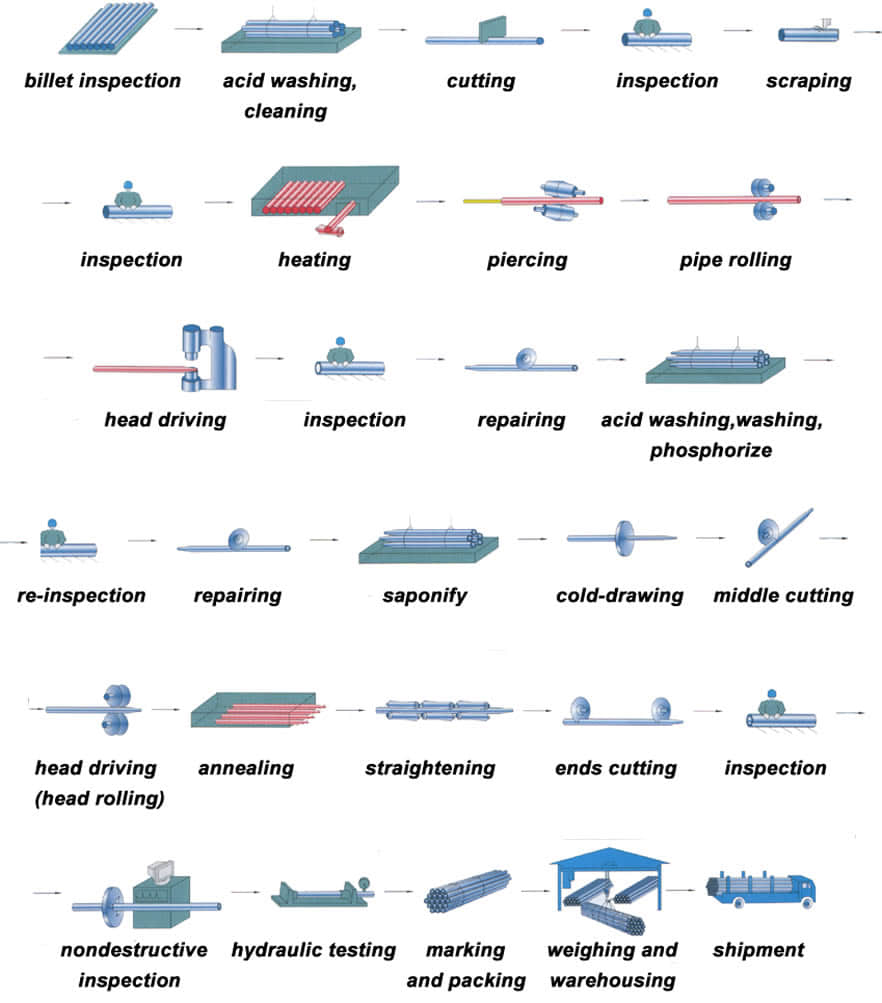 Cold drawn steel tube is with hot-rolled steel coil as raw material, and tandem cold rolling pickled to remove oxide scale, its finished rolling hard roll, rolling hard volumes due to the continuous cold deformation caused by cold hardening strength, hardness increased indicators declined tough plastic, stamping performance will deteriorate, which can only be used for simple deformation of the parts. Rolling hard roll can be used as the raw material of the hot-dip galvanizing plant, hot dip galvanizing line set annealing line. Rolling hard roll weight is generally 6 to 13.5 tons, the coil diameter of 610mm.
Cold drawn steel tube is with hot-rolled steel coil as raw material, and tandem cold rolling pickled to remove oxide scale, its finished rolling hard roll, rolling hard volumes due to the continuous cold deformation caused by cold hardening strength, hardness increased indicators declined tough plastic, stamping performance will deteriorate, which can only be used for simple deformation of the parts. Rolling hard roll can be used as the raw material of the hot-dip galvanizing plant, hot dip galvanizing line set annealing line. Rolling hard roll weight is generally 6 to 13.5 tons, the coil diameter of 610mm.
Hot-rolled seamless steel pipe production base deformation process can be summarized as three stages: perforation, extension and finishing. 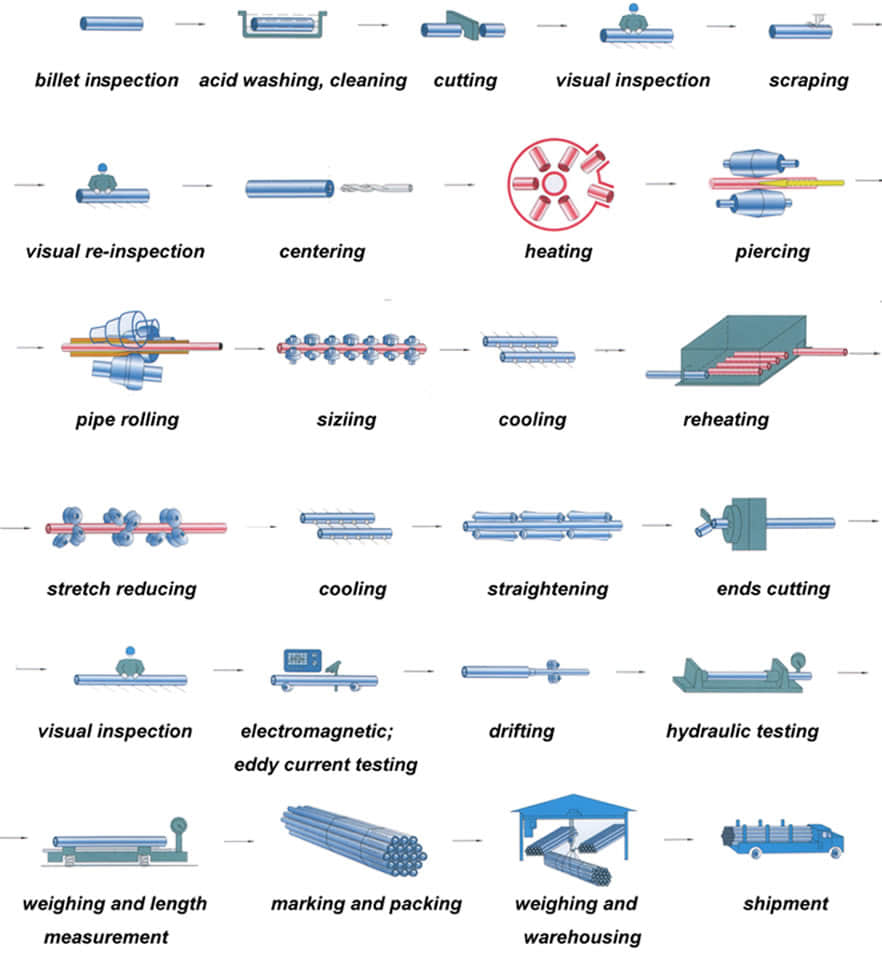 The main purpose of the perforation process is to become a solid round billet piercing hollow shell. Capillary in the specifications, accuracy and surface quality can not meet the requirements of the finished product, further improvements are needed to deform the metal through. The main purpose of the stretching machine is further reduced sectional view (main compression wall) for a larger axial extension, so that the capillary improved dimensional accuracy, surface quality and organizational performance. After stretching machine rolled steel pipe shortage collectively need further molding mill in order to achieve the requirements of the finished pipe. Rolled steel due to pass in the method widely used in the production of seamless steel tubes. So far, due to the method pass rolling steel can be divided into two categories: core pension without rolling rolling (hollow body rolling), and with the mandrel. Sizing machines, reducing mill and stretch reducing mill belonging to the hole without mandrel type continuous rolling mills are generally coffin. Its main purpose is to reduce the diameter of the deformation process or sizing get finished steel, the wall thickness of process control, can make thinning, thickening or nearly unchanged. All the traditional hole-type rolling machine with mandrel belong to extend machine. The main purpose is to reduce the deformation process perforated capillary wall thickness and outer diameter roll passes in the deformation zone and the mandrel posed, for a larger axial extension. At the same time a certain improvement in the organization, performance, accuracy, surface quality.
The main purpose of the perforation process is to become a solid round billet piercing hollow shell. Capillary in the specifications, accuracy and surface quality can not meet the requirements of the finished product, further improvements are needed to deform the metal through. The main purpose of the stretching machine is further reduced sectional view (main compression wall) for a larger axial extension, so that the capillary improved dimensional accuracy, surface quality and organizational performance. After stretching machine rolled steel pipe shortage collectively need further molding mill in order to achieve the requirements of the finished pipe. Rolled steel due to pass in the method widely used in the production of seamless steel tubes. So far, due to the method pass rolling steel can be divided into two categories: core pension without rolling rolling (hollow body rolling), and with the mandrel. Sizing machines, reducing mill and stretch reducing mill belonging to the hole without mandrel type continuous rolling mills are generally coffin. Its main purpose is to reduce the diameter of the deformation process or sizing get finished steel, the wall thickness of process control, can make thinning, thickening or nearly unchanged. All the traditional hole-type rolling machine with mandrel belong to extend machine. The main purpose is to reduce the deformation process perforated capillary wall thickness and outer diameter roll passes in the deformation zone and the mandrel posed, for a larger axial extension. At the same time a certain improvement in the organization, performance, accuracy, surface quality.
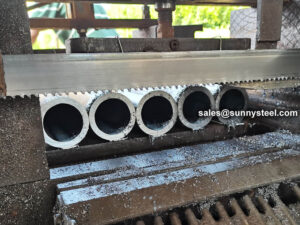
Before cutting pipe and tubing No matter the material, measure the diameter of the pipe or tube to be cut to ensure that you use the right-size tube cutter for the job. When determining how to make a straight cut, use a tape measure and a pencil or other writing instrument to mark on the surface where you want to cut. If possible, mark around the circumference of a pipe, especially when cutting with a handsaw. Ensure that a cut is as straight as possible by securing the pipe with a vise, clamp, miter box or even duct tape to keep the length from shifting out of place while cutting. After cutting pipe and tubing
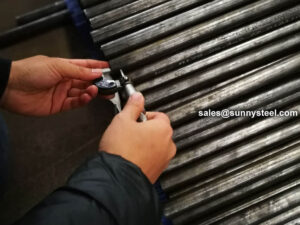
Geometrical inspection of steel pipes The outer diameter, wall thickness, bending and length of the steel pipe can be inspected on the inspection table with an outer caliper, a micrometer and a bending ruler, and a length tape measure.
Take seamless steel pipe as an example, there are some tolerances that affect quality. Noting this, and you will get a better pipe.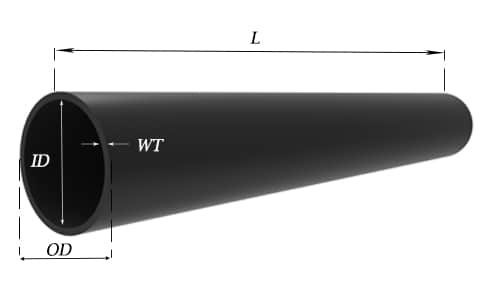
Weight tolerance
For pipe NPS 12 (DN300, 323.8mm) and under, the weight shall vary within -3.5% / +10%.
For pipe over NPS 12 (DN300, 323.8mm), the weight shall vary within -5% / +10%.
Pipe of NPS 4 (DN100, 114.3mm) and smaller may be weighed in convenient lots; pipe in sizes larger than NPS 4 shall be weighed separately.
Quantity tolerance
Normally mills take -10% to +10% tolerance, but TPMCSTEEL keeps ±3% variation.
Length tolerance
For Seamless pipe& tube, if definite cut lengths are ordered, the length shall vary within -0mm / +6mm.
| Pipe types | Pipe Szie(mm) | Tolerances | |
|---|---|---|---|
| Hot rolled | OD | <50 | ±0.50mm |
| ≥50 | ±1% | ||
| WT | <4 | ±12.5% | |
| ≥4-20 | +15%, -12.5% | ||
| >20 | ±12.5% | ||
| Cold drawn | OD | 6-10 | ±0.20mm |
| 10-30 | ±0.40mm | ||
| 30-50 | ±0.45 | ||
| >50 | ±1% | ||
| WT | <1 | ±0.15mm | |
| >1-3 | + 15%, – 10% | ||
| >3 | + 12.5%, – 10% | ||
| Standard | Hot finished seamless tube | Cold flnished seamless tube | ||
|---|---|---|---|---|
| Out diameter (mm) | Tolerance | Out diameter (mm) | Tolerance | |
| EN10216-1 | ≤100 | +/-0.75% (min.+/-0.5mm) | All | +/-0.5% |
| EN10216-2 | (min. +/-0.30mm) | |||
| DIN17175 | >100 | +/-0.90% | ||
| GB/T 3087 | ≤460 | +/-0.75% (min.+/-0.5mm) | 10-30 | +/-0.40mm |
| >30-50 | +/-0.45mm | |||
| >50 | +/-1.0% | |||
| GB/T 5310 GB/T 9948 GB/T 6479 | <57 | +/-0.40mm | ≤30 | +/-0.20mm |
| 57-325 | +/-0.75% | >30-50 | +/-0.30mm | |
| >325-460 | +1%,-2mm | >50 | +/-0.8% | |
| ASME SA-179M ASME SA-192M ASME SA-209M ASME SA-210M ASME SA-213M JIS G 3461 JIS G 3461 | ≤101.6 | +0.4, -0.8mm | <25.4 | +/-0.10mm |
| >25.4-38.1 | +/-0.15mm | |||
| >38.1-50.8 | +/-0.20mm | |||
| 101.6-190.5 | +0.4, -1.2mm | >50.8-63.5 | +/-0.25mm | |
| >63.5-76.2 | +/-0.30mm | |||
| >76.2 | +/-0.38mm | |||
| ASME SA106 ASME SA335 | ≤48.3 | +/-0.40mm | ≤48.3 | +/-0.40mm |
| 48.3-114.3 | +/-0.79mm | |||
| 114.4-219.1 | +1.59, -0.79mm | |||
| 219.2-323.9 | +2.38, -0.79mm | >48.3 | +/-0.79mm | |
| >324 | +/-1.0% | |||
| Standard | Hot finished seamless tube | Cold flnished seamless tube | ||||
|---|---|---|---|---|---|---|
| DIN17175 | Out diameter OD(mm) | Wall thickness T(mm) | Tolerance | Out diameter (mm) | Wall Thickness T(mm) | Tolerance |
| ≤130 | S≤2Sn | +15%, -10% | -- | All | +/-10% (min. +/-0.2mm) |
|
2Sn| +12.5%, -10% |
| |||||
| S>4Sn | +-/9% | |||||
| >130 | S≤0.05da | +17.5%, -12.5% | ||||
0.05da| +/-12.5% |
| |||||
| S>0.11da | +/-10% | |||||
| EN 10216-1 EN 10216-2 | ≤219.1 | - | +/-12.5% (min.+/-0.4mm) |
|||
| -- | T/D≤0.025 | +/-20% | ||||
0.025| +/-15% |
| |||||
0.05| +/-12.5% |
| |||||
0.1| +/-10% |
| |||||
| GB/T 3087 | -- | ≤20 | +15%,-12.5% (min.+0.45, -0.35mm) | -- | 1.0-3.0 | +15%, -10% |
| >20 | +/-12.5% | -- | >3 | +12.5%, -10% | ||
| GB/T 5310 GB/T 9948 GB/T 6479 | -- | <4.0 | +15%,-10% (min.+0.48, -0.32mm) | -- | 2-3 | +12%,-10% |
| 4-20 | +12.5%,-10% | >3 | +/-10% | |||
| >20 | +/-10% | |||||
| ASME SA-179M ASME SA-192M ASME SA-209M ASME SA-210M ASME SA-231M JIS G 3461 JIS G 3462 | -- | 2.41-3.8 | +35%, -0% | ≤38.1 | -- | +20%,-0% |
| 3.8-4.6 | +33%,-0% | >38.1 | -- | 22%,-0% | ||
| >4.6 | +28%,-0% | -- | -- | -- | ||
| ASME SA-106 ASME SA-335 | -- | All | +/12.5% | All | +/-10% | |
Note:

Positive material identification (PMI) testing is the examination of a material, usually a metallic alloy, to confirm the material is consistent with the user’s request.
Steel pipe delivery status(condition): cold / hard (BK), cold / soft (BKW), after cold stress relief annealing (BKS), annealing (GBK), normalized (NBK).
| Term | Symbol | Explanation |
|---|---|---|
| Cold-finished/hard (cold-finished as-drawn) | BK | No heat treatment after the last cold-forming process. The tubes therefore have only low deformability. |
| Cold-finished/soft (lightly cold-worked) | BKW | After the last heat treatment there is a light finishing pass (cold drawing) With proper subsequent processing, the tube can be cold-formed (e.g. bent, expanded) within certain limits. |
| Annealed | GBK | After the final cold-forming process the tubes are annealed in a controlled atmosphere or under vacuum. |
| Normalized | NBK | The tubes are annealed above the upper transformation point in a controlled atmosphere or under vacuum. |
There are probably hundreds of different methods for packing a pipe, and most of them have merit, but there are two principles that are vital for any method to work prevent rusting and Sea transportation security. 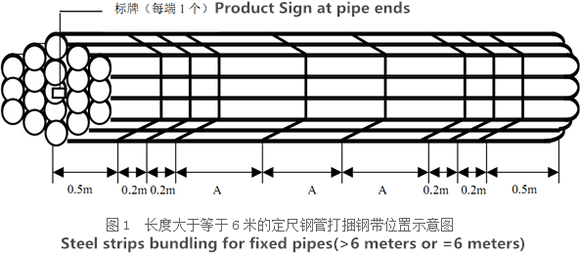
Our packing can meet any needs of the customers.
Need to inquire about our products? Fill out the form below and our staff will be in touch!
Q: How long is your delivery time? A: The delivery time of customized products is generally 25 35 days, and non customized products are generally shipped within 24 hours after payment. Q: Do you provide samples? Is it free? A: If the value of the sample is low, we will provide it for free, but the freight needs to be paid by the customer. But for some high value samples, we need to charge a fee. Q: What are your payment terms? A: T/T 30% as the deposit,The balance payment is paid in full before shipment Q: What is the packaging and transportation form? A: Non steaming wooden box and iron frame packaging. Special packaging is available according to customer needs. The transportation is mainly by sea. Q: What is your minimum order quantity? A: There is no minimum order quantity requirement. Customized products are tailor made according to the drawings provided by the customer.